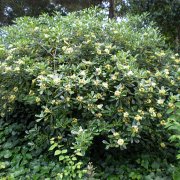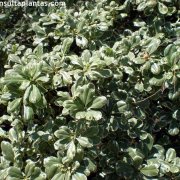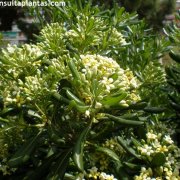Care of the shrub Pittosporum tobira or Japanese cheesewood |
|
The genus Pittosporum, family Pittosporaceae, comprises 200 species of trees and shrubs native to Oceania, Asia and Africa. Some species are: Pittosporum tobira, Pittosporum tenuifolium, Pittosporum truncatum, Pittosporum coriaceum, Pittosporum crassifolium, Pittosporum x pourtetianum, Pittosporum heterophyllum, Pittosporum angustifolium. Common names: Japanese pittosporum, Australian laurel, Japanese cheesewood, Mock orange. This species is native to China and Japan. They are evergreen shrubs that reach 10 meters (32.8 feet) in height. The leaves are spatulate in shape and bright green. The scented flowers are small and can be white, cream or yellow in color. They bloom during spring and early summer. The fruits are capsules where the red seeds are housed covered with a sticky liquid. Japanese cheesewood is used as isolated examples, for hedges and also in pots or planters with a minimum depth of 50 cm (1.64 feet). Pittosporum tobira can grow in full sun or semi-shade exposures. The soil can be a mixture of 1/4 garden substrate, 1/4 manure, 1/4 peat, and 1/4 coarse sand. Planting is done in autumn (in warm climates) or in spring (in cold regions). Australian laurel resists the proximity of the sea and the wind. Prune in autumn to maintain a compact bearing and strengthen the plant. Pittosporum tobira is a plant resistant to pests and diseases. Japanese pittosporum is propagated by seeds in spring, but the seeds are hard and germination is slow. Propagation by cuttings or by layering is done after flowering. |
Images of the shrub Pittosporum tobira or Japanese cheesewood |
Find plants
Pittosporum tobira or Japanese cheesewood | Care and Growing
© 2026 FavThemes







